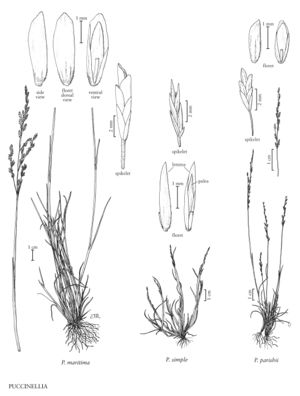Puccinellia parishii
Plants annual; not mat-forming. Culms 3-22 cm, erect. Leaves basally concentrated; ligules 1-2 mm, obtuse to truncate, entire; blades 0.2-1.2 mm wide, flat to involute. Panicles 1-8.5 cm, compact to diffuse at maturity, lower branches erect to descending, usually spikelet-bearing to the base; pedicels densely scabrous or with a few scattered scabrules, often with tumid epidermal cells. Spikelets 3.5-5 mm, with 2-7 florets. Glumes rounded over the back, veins obscure to prominent, apices acute to obtuse; lower glumes 1-2 mm; upper glumes 1.8-2.2 mm; calluses hairy; lemmas 1.8-2.2 mm, mostly herbaceous, densely hairy over the proximal 1/2 - 3/4 of the veins, glabrous between the veins, backs rounded, 5-veined, veins obscure to prominent, not extending to the margins, apical margins hyaline, smooth or with a few scattered scabrules, apices obtuse to truncate, entire; palea veins glabrous proximally, hairy at midlength, glabrous or scabrous-ciliate distally; anthers 0.4-0.5 mm. 2n = 14.
Distribution
Calif., Ariz., Colo., N.Mex.
Discussion
Puccinellia parishii grows in saline seepage areas in California, Arizona, and New Mexico.
Selected References
None.
